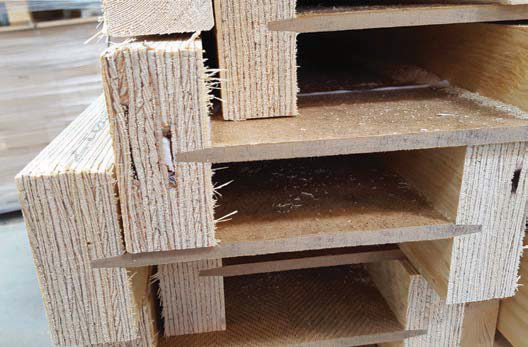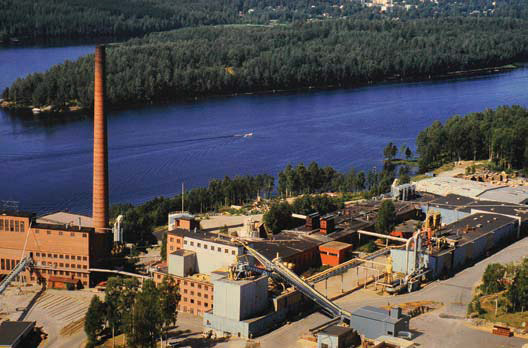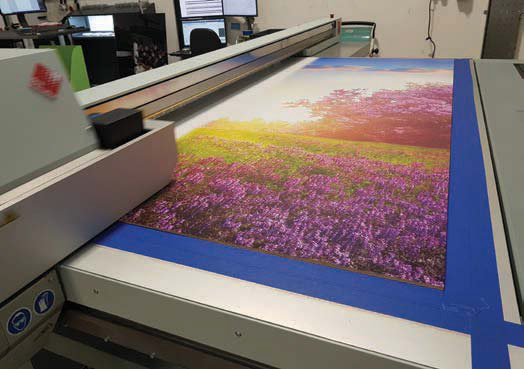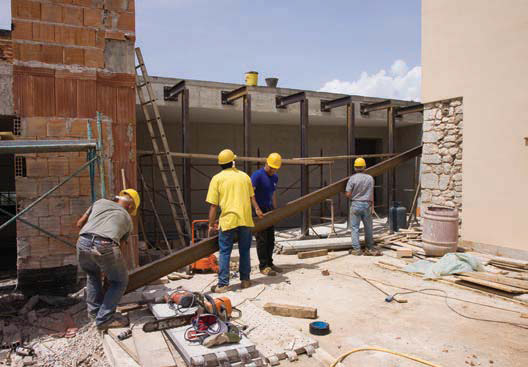Lion-Hearted Hardboard
29 June 2018The hardboard market in the UK might be small but it is growing. Sally Spencer reports
Peter Jones is a man on a mission. His objective is clear and simple – to reignite the UK’s interest in hardboard and reinstate it as a wood based panel of choice.
At approximately 25,000m3/year, the hardboard market in the UK is a shadow of its former self; it is thought to have topped 100,000m3 at its peak. However, it is starting to grow again and, according to Mr Jones, managing director at Finnish Fibreboard (UK) Ltd, the level of enquiries the company is receiving, where hardboard is being considered as an alternative to OSB, plywood and MDF, indicate “the market could easily top 50,000m3 in the short to medium term”.
Finnish Fibreboard is the market leading branded hardboard supplier, producing around 70,000m3 per year and exporting throughout Europe and further afield to Australia and Africa. Its largest market is Sweden, where demand has remained fairly consistent through the years and where it is used in the construction and packing sectors (as it is in Australia). The UK is its second largest market.
In the UK it arrives on weekly shipments into Tilbury, Hull and Grangemouth and monthly shipments to Belfast and moves from there to Finnish Fibreboard’s importer/distributor base, many of whom it has dealt with for decades. National distributors include James Latham, Meyer and Arnold Laver.
Manufacturing takes place on two lines at the company’s site in Heinola in Finland. The site was formerly a Schauman plywood mill and a hardboard line was set up in 1949 to use the wood by-products generated from plywood production.
Schauman later became part of UPM, which is still a shareholder in Finnish Fibreboard and which still supplies the hardboard plant with microchips. The other shareholder, Versowood, supplies sawdust for the production. In both cases the raw material is predominantly spruce and comes from highly sustainable sources.
Production Process
Hardboard manufacture is a wet process, combining wood and water rather than chemical binders, and is still produced on multi-daylight presses.
“This is what allows us to produce such consistent high density across the board,” said Mr Jones. “Many people don’t appreciate that hardboard is one of the densest timber panels produced – double the density of most plywoods and much denser than either MDF or HDF. And we don’t use formaldehyde resins to bond our panels together so this gives hardboard some unique qualities over other engineered panels.”
Despite these unique qualities hardboard has certainly dwindled in popularity but Mr Jones believes this is more down to the inexorable rise of newer products, such as MDF and our “insatiable appetite for new products”, rather than to any fundamental issues with the panel type.
“Undoubtedly the biggest hit to the hardboard market in the UK was the development of its own MDF industry,” he said. “Older people from the wood based panels industry will remember hardboard being used to prepare wooden subfloors to take carpets and resilient flooring and the majority of furniture makers would have used hardboard backs and drawer bottoms.
But many of our furniture customers moved to MDF panels when it came onto the market. Hardboard does have some technical advantages for these applications, although MDF has the price advantage.”
One negative impression that has to be overcome, said Mr Jones, is that many of those who do remember hardboard only recall the thin 3mm product, and some “rather dubious quality” hardboard imports that were on the market then and are still around today, which are “very wavy, have poor surface quality and do not perform well”. The perception of hardboard has been “somewhat marred” by these inferior products, he said.
Finnish Fibreboard’s own LION branded products are a different animal, he continued.
Core thicknesses start at 2mm and go up to 6mm and are available in numerous lengths – some even as long as 5490mm. The largest percentage of business to the UK is in 2440x1220 and 1220x610 panel sizes, while in other markets 3050x1220 is very popular and is the bigger seller overall.
The boards are produced in a wide range of qualities, depending on the final application. Most of the recipes are unique to the grade of board being produced.
The range includes the basic LION Protect product through to LION Superior and, in addition to these “natural” hardboards, there is LION Oil Tempered, which is similar to what people would recognise as MR. It is impregnated with a special oil which is polymerised by heat treatment during the manufacturing process, is suitable for use in Class 2 applications and is generally used within the construction sector.
It is complemented by specialist boards such as LION Floor and LION HD Panel. The latter was formerly known as LION Farm because it was originally developed as a robust, environmentally benign panel for lining pigpens. It was rebranded when the company realised that farmers were also using it for full-scale construction projects – in fact, 80% of the supply was being used this way.
Most LION boards can be painted and all can be perforated – something that has become popular for acoustic applications, such as desk dividers and in music rooms, and in the furniture sector where it is being used for, amongst other things, bed bases.
Van linings are another growing market and another where hardboard is starting to take some market share from plywood, said Mr Jones. “They are able to use 4.8mm hardboard rather than 5.5mm plywood and the perforations cut down on the weight, while allowing greater utilisation of the van walls.”
He added that sales of perforated hardboard have risen by 60-70% per year over the past four years, although admittedly from a low base.
“It is a Europe-wide trend,” said Mr Jones. “We now have distributors stocking it who used not to, other customers who would sell it to order but who are now talking about taking it into stock and certain DIY chains are now considering reintroducing perforated hardboard.”
The company’s LION Floor product is also on the march.
“With the publishing of the new, very demanding BS 8203:2017 standard for resilient flooring we are experiencing a growth in demand for 4.8mm LION Floor as a fabricated underlay as an alternative to 6mm flooring grade plywood,” said Mr Jones.
One reason he believes hardboard fell out of favour with flooring contractors is that for decades the advice was to wet the board – which despite being made with water is naturally very dry, with a 4-5% moisture content – and to fix it while still slightly damp and expanded. This resulted in an extremely taut board that wouldn’t expand if humidity increased. It was, however, an extra task and, combined with a change in sub-floor material from solid timber to particleboard, contractors simply couldn’t risk getting the flooring grade particleboard wet.
Today, however, Lion Floor is preconditioned, with a moisture content of 8-10%, the same as good quality flooring grade plywood.
Potential Markets
Another area with potential is in temporary protection on construction sites.
“Many years ago hardboard was used extensively in this application but contractors have moved toward plastic-based protective sheeting. So we recently launched a 2mm LION Protect product, which has been specifically designed to persuade stockists of plastic-based sheeting to consider offering a more environmentally friendly and better performing product. It can be reused several times and is biodegradable, savings costs on expensive plastic disposal.
“When in use it offers far superior impact resistance and, when installed correctly, can offer a natural non-slip surface.”
This mesh, or rough surface on one side is a result of the hardboard production process. While MDF and particleboard manufacture uses solid steel plates top and bottom, resulting in a smooth surface on both sides of the panel, hardboard production has a solid steel plate for the top and a mesh plate at the bottom to provide the water with a means of escape during pressing.
“Because hardboard is higher density than MDF or particleboard the mat is much thicker than either of them and the water has to have somewhere to go,” said Mr Jones.
“For certain applications MDF has been fantastic because it has two smooth faces but for applications such as floor protection hardboard provides the density and a nonslip surface. It also provides an entrance matting-like function, taking grit off boots.”
He added that Saint-Gobain’s UK national builders merchant, Jewson, has just started to stock 2mm Lion Protect.
The company is also discussing a number of “niche” uses for LION hardboard, which it is unable to disclose because of confidentiality agreements “but they will involve replacing 11mm OSB through to various thicknesses of plywood”.
Mr Jones added that in terms of winning market share from plywood, the biggest gains “without question” were down to supply issues of South-east Asian plywood and he believed that a continuation of this could comfortably add another 20,000m3 of hardboard to UK consumption.
It is certainly a frustration for Peter Jones that hardboard has dropped off the radar somewhat but it does, at least, give him plenty to aim for.
He does, however, conduct regular training sessions with the company’s direct customers’ sales forces, “encouraging them to think about whether hardboard would suit a particular job and then offering it as an alternative”.
“This what has brought us these new opportunities,” he said.



